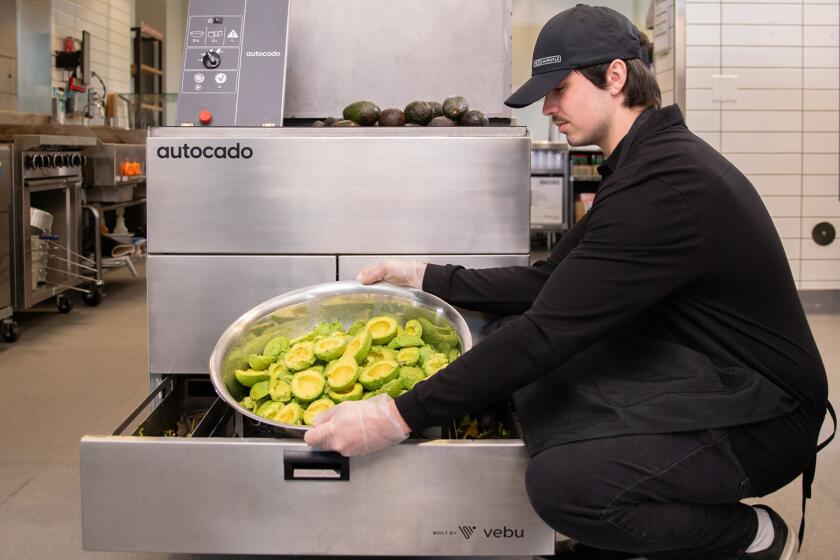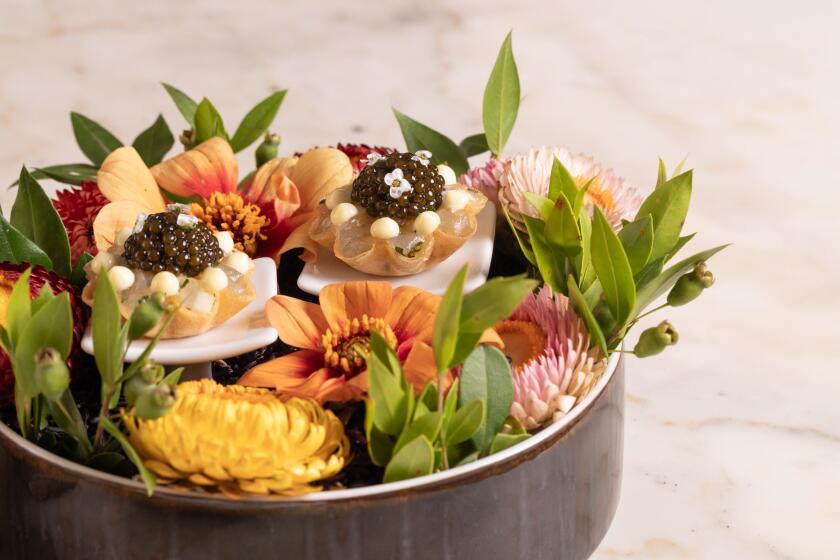Diana Henry’s new cookbook celebrates where healthy meets delicious
I’m categorically allergic to diet books or anything with the words skinny, thin, vegan or gluten-free in the title. But healthy meets delicious? That’s a slogan I could follow. And it just happens to be the subtitle of British food writer Diana Henry’s new cookbook, “A Change of Appetite: Where Healthy Meets Delicious” (Mitchell Beazley/Octopus Books USA).
Hey, you don’t get a recommendation much better than Yotam Ottolenghi’s quote, “Everything Diana Henry cooks I want to eat,” on the book’s cover.
I’d follow Henry almost anywhere. I think I have most of her previous seven cookbooks in my arsenal, including “Crazy Water, Pickled Lemons” and ”Salt Sugar Smoke” — and I look in on her weekly column in London’s Sunday Telegraph from time to time.
She’s a wonderful cook — and even more rare, writes a wonderful recipe — so I was thrilled when her new book came down the pike this summer. These are the dishes Henry created when she started to crave a different kind of diet — less meat and heavy food, more vegetable-, fish- and grain-based dishes. I’m finding myself at that point, too, so this book comes along at just the right time.
“A Change of Appetite” is not just another Mediterranean cookbook, but wanders all over the map. “When I started to put together lists of ‘accidentally healthy’ dishes,” she writes, “I found they were the kind I wanted to eat anyway.” She adds, “My love of Middle Eastern food goes way back, and that’s a healthy place to start, but I also plundered the cuisines of Japan, Thailand, and Vietnam.”
Deprivation is not on the menu. She points out that none of the recipes are “cranky” or “punishing”—or she wouldn’t eat them. “This is good food for people who love eating,” she says.
Just looking at the photos by Laura Edwards, I want to get cooking. Spring dishes include a gorgeous Persian salad of radishes, cucumber, salad greens and herbs scattered with edible flowers. She has a a Peruvian chicken soup with leeks, potatoes, hard-boiled eggs and cilantro or a Persian saffron and mint chicken with spring couscous.
For Angelenos, though the calendar says September, it’s still summer, and so I’m looking at her salad of nectarine, tomato and basil with torn mozzarella and her Burmese salad with cubed melon, ginger and herbs. She’s got a number of great recipes for whole fish and chicken, of course, but also lamb kebabs with a searing Georgian hot sauce and lamb scottadito with fregola (the large couscous from Sardinia).
Come fall, I’ll be making her roasted tomatoes and lentils with dukka-crumbed eggs and the beluga lentil salad with roasted grapes and red Belgian endive.
Meanwhile, here’s one recipe from the book that intrigues me:
Sweet saffron-roasted tomatoes with labneh
“Saffron and hot spices, sweet tomato flesh, clean acidic yogurt, there is an irresistible interplay of flavors here. Try to make sure you get some of the saffron juices to smear the labneh; the golden streaks on creamy white yogurt look beautiful.
Make this a complete main course by serving couscous on the side, or try kamut flavored with preserved lemons. You can sprinkle either pistachios or almonds on top.”
(Note: This recipe has not been tested by the Los Angeles Times Test Kitchen.)
Serves 8
For the labneh
1¾ cups Greek yogurt
2 garlic cloves, crushed
3 tablespoons finely chopped cilantro, mint or parsley leaves
Pinch of salt
Black pepper
For the tomatoes
18 plum tomatoes
¼ cup olive oil
2 teaspoons harissa
Good pinch of saffron stamens, plus extra to serve
½ tablespoon sugar (unless you have great sweet tomatoes)
To serve
Arab flatbread
1½ cups slivered almonds,lightly toasted
Juice of ½ lemon
¼ cup extra virgin olive oil
2 tablespoons choppedcilantro leaves
1. Make the labneh the day before you want to serve the dish. Line a strainer with a piece of cheesecloth and set it over a bowl. Mix the yogurt with the garlic, herbs, salt and black pepper. Transfer to the cloth, tie it up and refrigerate. The yogurt will lose moisture over the next 24 hours, producing a firmer, “cheese-like” substance. Help it along by giving it a squeeze every so often.
2. Heat the oven to 375 degrees. Halve the tomatoes and lay them in a single layer in a large roasting pan (or two small pans). Mix the regular olive oil, harissa and saffron and pour the dressing over the tomatoes. Turn the tomatoes over in the oil to make sure they are well coated, ending with them cut side up. Sprinkle with the sugar and season. Roast in the oven for about 45 minutes, or until caramelized and slightly shrunken. Let cool a little.
3. Take the labneh out of its cloth.
4. Carefully move the tomatoes (they will be fragile and can fall apart easily) to a serving plate, dotting nuggets of the labneh among them as you work. You can also toast the flatbread, break it up and arrange it among the tomatoes as well (or serve it on the side). Pour on any cooking juices that have collected in the tomato roasting pan, being sure to douse the flatbread if you have included it within the dish.
5. Sprinkle the almonds over the top, then heat another good pinch of saffron stamens with the lemon juice in a small saucepan. Add the extra virgin olive oil and mix with a spoon. Spoon the mixture over the dish; the golden dressing looks beautiful against the white labneh. Sprinkle with the cilantro and serve warm, or at room temperature.
Follow @sirenevirbila for more on food and wine.
More to Read
Eat your way across L.A.
Get our weekly Tasting Notes newsletter for reviews, news and more.
You may occasionally receive promotional content from the Los Angeles Times.










